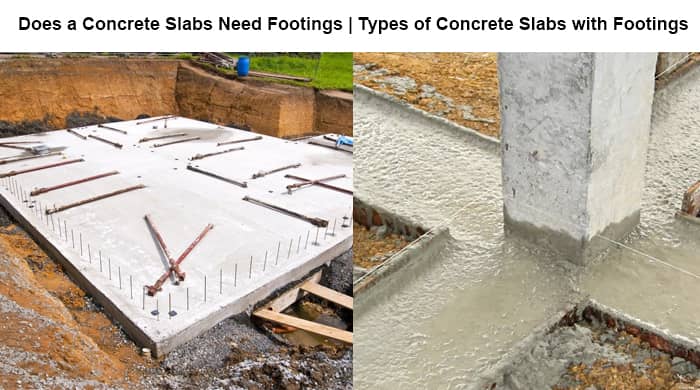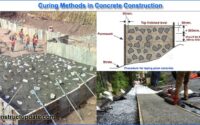Why Concrete Slabs Need Footings | Types Of Concrete Slabs With Footings
Does A Concrete Slab Need Footings?
If a concrete slab is being used as a patio, driveway, or sidewalk, footings are not necessary. The slab, however, requires a footing if it serves as a foundation. All load-bearing walls, columns, and support structures in modern dwellings must have footings underneath them to support the weight above. Along the whole perimeter and beneath all load points, the footings sit immediately beneath the slab.
In order to reduce heaving brought on by the freeze/thaw cycle, slab foundation footings are typically at least 3 feet deep or below the frost line.
For the following reasons, footings are necessary for a concrete slab foundation:
- Help prevent water from seeping beneath the slab.
- Provide support for all load-bearing members.
- Help the slab resist cracking and settling.
- Resist heaving and shifting caused by the freeze/thaw cycles.
- Prevent animals from burrowing under the slab.
- Give buildings a strong anchor point to help with high winds and earthquakes.

The footings for contemporary concrete slab foundations must be strengthened with rebar. Then, anchor bolts are used to secure any building that is placed on top of the slab to the footings. This contributes to building a construction with a highly solid and robust base.
Many earlier slab-built houses lacked footings. They just have a concrete slab, and the perimeter may or may not have a little concrete trench beneath it. This style of building, which was popular for tiny ranches and shacks, is now illegal.
Why Do You Need Footings for Your Concrete Foundation?
To provide a solid, stable foundation, concrete footings are necessary. It is common for a shallow foundation slab to degrade, harming the structure that is built on top of it. If you reside in an area with a harsh winter, shallow slabs are more likely to tilt, heave, and break. Rainwater runoff can readily weaken a shallow slab foundation, even if you live in a warm climate. The foundation tilts as a result of this.
Footings are essential to a durable foundation.
Most building codes require foundations to have footings.
It’s important to realize that most construction regulations call for footings for any concrete foundation. When constructing a garage, a house addition, or the majority of other constructions, it is essential to create designs that are based on solid principles. This is required in order to acquire a building permit. You must also show that you adhered to the drawings precisely and built a foundation with the proper footings. If not, your building can be deemed illegal.
Types Of Concrete Slabs With Footings
Concrete slab foundation footings come in a variety of designs. a typical slab with footings, a monolithic slab, and a floating slab.
Typical Slab With Footings: The slab with footings is the one most frequently utilized in construction. A footing is a significant amount of concrete that is poured below grade and acts as the foundation of the house. After it has been poured, the slab is placed over the footing.
A floating slab is built over footings similarly to a regular slab, but the slab floor is poured after the footings and foundation walls are built. This suggests that while it “floats” or rests on the footing, it only bears a portion of the building’s weight.
A monolithic slab foundation with footings is the least common kind of foundation. Only smaller jobs often require the pouring of monolithic slabs. The footing is joined by a monolithic slab, which is concurrently poured.
The structure you’re building, the characteristics of the site, and the requirements of the local building code will determine the appropriate kind of concrete slab with footings. Before planning and/or constructing a slab, think about seeking advice from an engineer, architect, or building authority.
What is Wrong With a Slab Foundation Without Footings?
Any structure built on top of a slab foundation without footings will fail. In the best-case scenario, the slab will heave and crack, resulting in minor damage to the structure above it. In the worst situation, the slab might shift significantly, break off in some spots, or tilt. This could seriously harm the structure that is built on top of the slab.
Without adequate concrete footers, slabs will shift, tilt, or crack.
Buildings on plains laboratories may sustain damage as the slab ages.
Under plain slabs, pest animals dig burrows. Burrowing animals are deterred by footers.
Concrete slabs without footings have the unavoidable tendency to attract pest animals, a disadvantage that is rarely mentioned. Raccoons, coyotes, woodchucks, and skunks can all easily burrow under a thin concrete slab. In addition to bringing bugs into your yard, this also weakens the foundation. Since animals rarely dig down far enough to reach the footing, a slab with a deep footing repels them.





